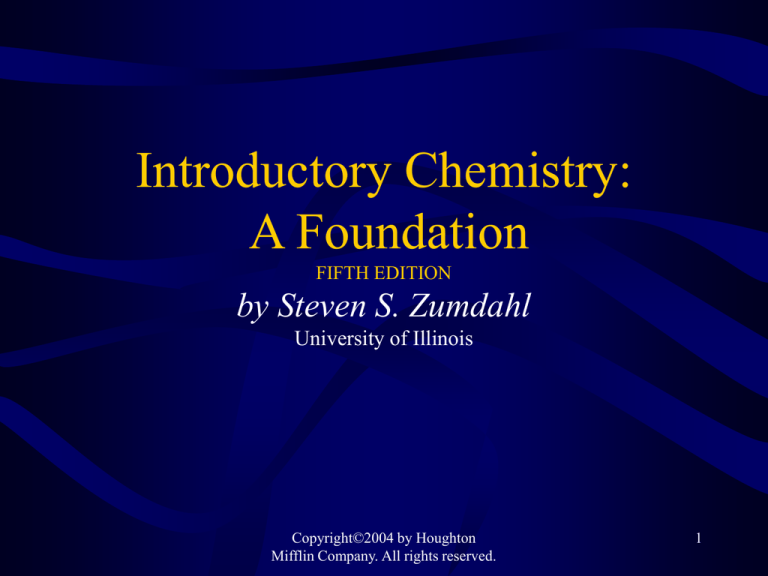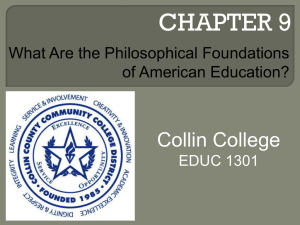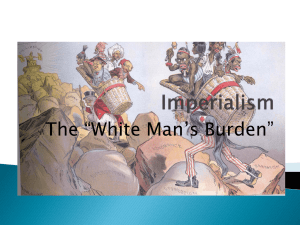
Introductory Chemistry:
A Foundation
FIFTH EDITION
by Steven S. Zumdahl
University of Illinois
Copyright©2004 by Houghton
Mifflin Company. All rights reserved.
1
Chemical Reactions:
An Introduction
Chapter 6
Copyright©2004 by Houghton
Mifflin Company. All rights reserved.
2
Chemical Reactions
• Reactions involve chemical changes in
matter resulting in new substances
• Reactions involve rearrangement and
exchange of atoms to produce new
molecules
– Elements are not transmuted during a reaction
Reactants Products
Copyright©2004 by Houghton
Mifflin Company. All rights reserved.
3
Evidence of Chemical Reactions
• a chemical change occurs when new
substances are made
• visual clues (permanent)
– color change, precipitate formation, gas
bubbles, flames, heat release, cooling, light
• other clues
– new odor, permanent new state
Copyright©2004 by Houghton
Mifflin Company. All rights reserved.
4
Evidence of Chemical Reactions:
Color Change
Copyright©2004 by Houghton
Mifflin Company. All rights reserved.
5
Evidence of Chemical Reactions
Copyright©2004 by Houghton
Mifflin Company. All rights reserved.
6
Chemical Equations
• Shorthand way of describing a reaction
• Provides information about the reaction
– Formulas of reactants and products
– States of reactants and products
– Relative numbers of reactant and product
molecules that are required
– Can be used to determine weights of reactants
used and of products that can be made
Copyright©2004 by Houghton
Mifflin Company. All rights reserved.
7
Conservation of Mass
• Matter cannot be created or destroyed
• In a chemical reaction, all the atoms present
at the beginning are still present at the end
• Therefore the total mass cannot change
• Therefore the total mass of the reactants
will be the same as the total mass of the
products
Copyright©2004 by Houghton
Mifflin Company. All rights reserved.
8
Combustion of Methane
• methane gas burns to produce carbon dioxide gas
and liquid water
– whenever something burns it combines with O2(g)
CH4(g) + O2(g) CO2(g) + H2O(l)
O
H
H
C
H
H
+
O
O
C
+
O
H
H
O
1C+4H
+
2O
1C+2O +2H+O
1C+2H+3O
Copyright©2004 by Houghton
Mifflin Company. All rights reserved.
9
Combustion of Methane
Balanced
• to show the reaction obeys the Law of
Conservation of Mass it must be balanced
CH4(g) + 2 O2(g) CO2(g) + 2 H2O(l)
H
H
C
H
H
O
+
O
C
+
O
O
O
1C + 4H + 4O
Copyright©2004 by Houghton
Mifflin Company. All rights reserved.
O
O
+
H
H
+
O
H
H
1C + 4H + 4O
10
Writing Equations
• Use proper formulas for each reactant and product
• proper equation should be balanced
– obey Law of Conservation of Mass
– all elements on reactants side also on product side
– equal numbers of atoms of each element on reactant side as on
product side
• balanced equation shows the relationship between the
relative numbers of molecules of reactants and products
– can be used to determine mass relationships
Copyright©2004 by Houghton
Mifflin Company. All rights reserved.
11
Symbols Used in Equations
• symbols used after chemical formula to
indicate physical state
– (g) = gas; (l) = liquid; (s) = solid
– (aq) = aqueous, dissolved in water
Copyright©2004 by Houghton
Mifflin Company. All rights reserved.
12
Sample – Recognizing Reactants and Products
•
when magnesium metal burns in air it produces a
white, powdery compound magnesium oxide
– burning in air means reacting with O2
– Metals are solids, except for Hg which is liquid
write the equation in words
– identify the state of each chemical
magnesium(s) + oxygen(g) magnesium oxide(s)
write the equation in formulas
– identify diatomic elements
– identify polyatomic ions
– determine formulas
Mg(s) + O2(g) MgO(s)
Copyright©2004 by Houghton
Mifflin Company. All rights reserved.
13
Balancing Chemical Equations
Count atoms of each element
a polyatomic ions may be counted as one “element” if it
does not change in the reaction
Al + FeSO4 Al2(SO4)3 + Fe
1 SO4 3
b if an element appears in more than one compound on
the same side, count each separately and add
CO + O2 CO2
1 + 2 O 2
Copyright©2004 by Houghton
Mifflin Company. All rights reserved.
14
Balancing Chemical Equations
Pick an element to balance
a avoid elements from 1b
Find Least Common Multiple and factors
needed to make both sides equal
Use factors as coefficients in equation
a if already a coefficient then multiply by new
factor
°
Recount and Repeat until balanced
Copyright©2004 by Houghton
Mifflin Company. All rights reserved.
15
Example 1:
Magnesium metal burns in air
• when magnesium metal burns in air it
produces a white, powdery compound
magnesium oxide
– burning in air means reacting with O2
write the equation in words
magnesium(s) + oxygen(g) magnesium oxide(s)
write the equation in formulas - determine formulas
Mg(s) + O2(g) MgO(s)
Copyright©2004 by Houghton
Mifflin Company. All rights reserved.
16
Example 1:
Magnesium metal burns in air
count the number of atoms of on each side
Mg(s) + O2(g) MgO(s)
1 Mg 1
2O1
Copyright©2004 by Houghton
Mifflin Company. All rights reserved.
17
Example 1:
Magnesium metal burns in air
pick an element to balance
- avoid element in multiple compounds
Mg(s) + O2(g) MgO(s)
1 Mg 1
1x2O1x2
Copyright©2004 by Houghton
Mifflin Company. All rights reserved.
18
Example 1:
Magnesium metal burns in air
Mg(s) + O2(g) 2 MgO(s)
1 Mg 1
1x2O1x2
Use factors as coefficients in front of compound
containing the element
if coefficient already there, multiply them together
Copyright©2004 by Houghton
Mifflin Company. All rights reserved.
19
Example 1:
Magnesium metal burns in air
Recount
Mg(s) + O2(g) 2 MgO(s)
1 Mg 2
2O2
Repeat
2 Mg(s) + O2(g) 2 MgO(s)
2 x 1 Mg 2
2O2
Copyright©2004 by Houghton
Mifflin Company. All rights reserved.
20
Example 2
•
•
Under appropriate conditions at 1000°C ammonia gas
reacts with oxygen gas to produce gaseous nitrogen
monoxide and gaseous water
write the equation in words
ammonia(g) + oxygen(g) nitrogen monoxide(g) + water(g)
write the equation in formulas
NH3(g) + O2(g) NO(g) + H2O(g)
Copyright©2004 by Houghton
Mifflin Company. All rights reserved.
21
Examples
count the number of atoms of on each side
NH3(g) + O2(g) NO(g) + H2O(g)
1 N 1
3H2
2O1+1
Copyright©2004 by Houghton
Mifflin Company. All rights reserved.
22
Examples
pick an element to balance - avoid element in
multiple compounds
NH3(g) + O2(g) NO(g) + H2O(g)
1 N 1
2x3H2x3
2O1+1
Copyright©2004 by Houghton
Mifflin Company. All rights reserved.
23
Examples
Use factors as coefficients in front of compound
containing the element
2 NH3(g) + O2(g) NO(g) + 3 H2O(g)
1 N 1
2x3H2x3
2O1+1
Copyright©2004 by Houghton
Mifflin Company. All rights reserved.
24
Examples
Recount
2 NH3(g) + O2(g) NO(g) + 3 H2O(g)
2 N 1
6H6
2O1+3
Repeat
2 NH3(g) + O2(g) 2 NO(g) + 3 H2O(g)
2 N 1 x 2
6H6
2O1+3
Copyright©2004 by Houghton
Mifflin Company. All rights reserved.
25
Examples
´
Recount
2 NH3(g) + O2(g) 2 NO(g) + 3 H2O(g)
2 N 2
6H6
2O2+3
Copyright©2004 by Houghton
Mifflin Company. All rights reserved.
26
Examples
Repeat
– A trick of the trade, when you are forced to attack an
element that is in 3 or more compounds – find where it is
uncombined. You can find a factor to make it any amount
you want, even if that factor is a fraction!
– We want to make the O on the left equal 5, therefore we
will multiply it by 2.5
2 NH3(g) + 2.5 O2(g) 2 NO(g) + 3 H2O(g)
2 N 2
6H6
2.5 x 2 O 2 + 3
Copyright©2004 by Houghton
Mifflin Company. All rights reserved.
27
Examples
Multiply all the coefficients by a number to
eliminate fractions:
2 x [2 NH3(g) + 2.5 O2(g) 2 NO(g) + 3 H2O(g)]
4 NH3(g) + 5 O2(g) 4 NO(g) + 6 H2O(g)
4 N 4
12 H 12
10 O 10
Copyright©2004 by Houghton
Mifflin Company. All rights reserved.
28







